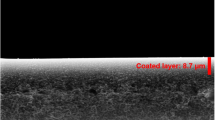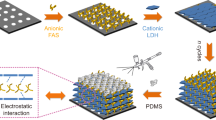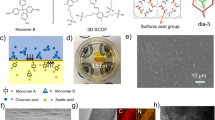Abstract
To examine the potential of ion gels as materials for CO2 separation membranes, inorganic/organic double-network ion gel (DN ion gel) membranes with different ionic liquid (IL) contents were fabricated. The composition of the inorganic and organic networks was optimized to maximize the mechanical strength of the DN ion gel. The DN ion gel with an inorganic/organic network composition of 0.35 mol/mol showed the maximum mechanical strength because the inorganic and organic networks sufficiently acted as sacrificial bonds and hidden lengths, respectively. Using DN ion gel membranes with different IL contents prepared with the optimized precursor solution, the relationship between the CO2 permeability and IL content of the DN ion gel membranes was examined. The DN ion gel membrane with 95.2 wt% IL had a CO2 permeability of 1380 barrer, which was ~67% of the theoretical maximum predicted for the pure IL membrane. The CO2 permeability of the DN ion gel membrane exponentially increased with increasing IL content and approached the theoretical maximum. DN ion gels with high strength can be used to develop maximum-performance IL-based CO2 separation membranes by giving the membrane the maximum IL potential.
This is a preview of subscription content, access via your institution
Access options
Subscribe to this journal
Receive 12 print issues and online access
$259.00 per year
only $21.58 per issue
Buy this article
- Purchase on Springer Link
- Instant access to full article PDF
Prices may be subject to local taxes which are calculated during checkout








Similar content being viewed by others
References
Dai Z, Noble RD, Gin DL, Zhang X, Deng L. Combination of ionic liquids with membrane technology: a new approach for CO2 separation. J Membr Sci. 2016;497:1–20.
Gao H, Bai L, Han J, Yang B, Zhang S, Zhang X. Functionalized ionic liquid membranes for CO2 separation. Chem Commun. 2018;54:12671–85.
Yan X, Anguille S, Bendahan M, Moulin P. Ionic liquids combined with membrane separation processes: a review. Sep Purif Technol. 2019;222:230–53.
Finotello A, Bara JE, Narayan S, Camper D, Noble RD. Ideal gas solubilities and solubility selectivities in a binary mixture of room-temperature ionic liquids. J Phys Chem B. 2008;112:2335–9.
Merkel TC, Lin H, Wei X, Baker R. Power plant post-combustion carbon dioxide capture: an opportunity for membranes. J Membr Sci. 2010;359:126–39.
Scovazzo P, Kieft J, Finan DA, Koval C, DuBois D, Noble R. Gas separations using non-hexafluorophosphate [PF6]− anion supported ionic liquid membranes. J Membr Sci. 2004;238:57–63.
Bara JE, Gabriel CJ, Hatakeyama ES, Carlisle TK, Lessmann S, Noble RD, et al. Improving CO2 selectivity in polymerized room-temperature ionic liquid gas separation membranes through incorporation of polar substituents. J Membr Sci. 2008;321:3–7.
Scovazzo P. Determination of the upper limits, benchmarks, and critical properties for gas separations using stabilized room temperature ionic liquid membranes (SILMs) for the purpose of guiding future research. J Membr Sci. 2009;343:199–211.
Mahurin SM, Yeary JS, Baker SN, Jiang D-e, Dai S, Baker GA. Ring-opened heterocycles: Promising ionic liquids for gas separation and capture. J Membr Sci. 2012;401-402:61–7.
Gouveia ASL, Tome LC, Lozinskaya EI, Shaplov AS, Vygodskii YS, Marrucho IM. Exploring the effect of fluorinated anions on the CO2/N2 separation of supported ionic liquid membranes. Phys Chem Chem Phys. 2017;19:28876–84.
Tome LC, Guerreiro DC, Teodoro RM, Alves VD, Marrucho IM. Effect of polymer molecular weight on the physical properties and CO2/N2 separation of pyrrolidinium-based poly(ionic liquid) membranes. J Membr Sci. 2018;549:267–74.
Carlisle TK, Nicodemus GD, Gin DL, Noble RD. CO2/light gas separation performance of cross-linked poly(vinylimidazolium) gel membranes as a function of ionic liquid loading and cross-linker content. J Membr Sci. 2012;397-398:24–37.
Cowan MG, Gin DL, Noble RD. Poly(ionic liquid)/ionic liquid ion-gels with high “free” ionic liquid content: platform membrane materials for CO2/light gas separations. Acc Chem Res. 2016;49:724–32.
Zhou J, Mok MM, Cowan MG, McDanel WM, Carlisle TK, Gin DL, et al. High-permeance room-temperature ionic-liquid-based membranes for CO2/N2 separation. Ind Eng Chem Res. 2014;53:20064–7.
Kasahara S, Kamio E, Yoshizumi A, Matsuyama H. Polymeric ion-gels containing an amino acid ionic liquid for facilitated CO2 transport media. Chem Commun. 2014;50:2996–9.
Hayashi E, Thomas ML, Hashimoto K, Tsuzuki S, Ito A, Watanabe M. Application of protic ionic liquids to CO2 separation in a sulfonated polyimide-derived ion gel membrane. ACS Appl Polym Mater. 2019;1:1579–89.
Fujii K, Asai H, Ueki T, Sakai T, Imaizumi S, Chung U-i, et al. High-performance ion gel with tetra-PEG network. Soft Matter. 2012;8:1756–9.
Lodge TP. Materials science: a unique platform for materials design. Science. 2008;321:50–1.
Gu Y, Zhang S, Martinetti L, Lee KH, McIntosh LD, Frisbie CD, et al. High toughness, high conductivity ion gels by sequential triblock copolymer self-assembly and chemical cross-linking. J Am Chem Soc. 2013;135:9652–5.
Moghadam F, Kamio E, Yoshizumi A, Matsuyama H. An amino acid ionic liquid-based tough ion gel membrane for CO2 capture. Chem Commun. 2015;51:13658–61.
Moghadam F, Kamio E, Yoshioka T, Matsuyama H. New approach for the fabrication of double-network ion-gel membranes with high CO2/N2 separation performance based on facilitated transport. J Membr Sci. 2017;530:166–75.
Kamio E, Yasui T, Iida Y, Gong JP, Matsuyama H. Inorganic/organic double-network gels containing ionic liquids. Adv Mater. 2017;29:1704118.
Yasui T, Kamio E, Matsuyama H. Inorganic/organic double-network ion gels with partially developed silica-particle network. Langmuir. 2018;34:10622–33.
Fujii K, Makino T, Hashimoto K, Sakai T, Kanakubo M, Shibayama M. Carbon dioxide separation using a high-toughness ion gel with a tetra-armed polymer network. Chem Lett. 2015;44:17-9/1-9/3, 3 pp.
Gu Y-Y, Lodge TP. Synthesis and gas separation performance of triblock copolymer ion gels with a polymerized ionic liquid mid-block. Macromolecules. 2011;44:1732–6.
Moghadam F, Kamio E, Matsuyama H. High CO2 separation performance of amino acid ionic liquid-based double network ion gel membranes in low CO2 concentration gas mixtures under humid conditions. J Membr Sci. 2017;525:290–7.
Kamio E, Matsuki T, Moghadam F, Matsuyama H. Development of facilitated transport membranes with low viscosity aprotic heterocyclic anion type ionic liquid as a CO2 carrier. Sep Sci Technol. 2017;52:197–208.
Gong JP, Katsuyama Y, Kurokawa T, Osada Y. Double-network hydrogels with extremely high mechanical strength. Adv Mater. 2003;15:1155–8.
Yasui T, Kamio E, Matsuyama H. Tough and stretchable inorganic/organic double network ion gel containing gemini-type ionic liquid as a multiple hydrogen bond cross-linker. RSC Adv. 2019;9:11870–6.
Yasui T, Kamio E, Matsuyama H. Inorganic/organic nanocomposite ion gels with well dispersed secondary silica nanoparticles. RSC Adv. 2020;10:14451–7.
Yasui T, Fujinami S, Hoshino T, Kamio E, Matsuyama H. Energy dissipation via the internal fracture of the silica particle network in inorganic/organic double network ion gels. Soft Matter. 2020;16:2363–70.
Ogston AG. The spaces in a uniform random suspension of fibres. Trans Faraday Soc. 1958;54:1754–7.
Hou Y, Baltus RE. Experimental measurement of the solubility and diffusivity of CO2 in room-temperature ionic liquids using a transient thin-liquid-film method. Ind Eng Chem Res. 2007;46:8166–75.
Acknowledgements
Parts of this work were supported by KAKENHI (18K04812) of the Japan Society for the Promotion of Science (JSPS).
Author information
Authors and Affiliations
Corresponding author
Ethics declarations
Conflict of interest
The authors declare that they have no conflict of interest.
Additional information
Publisher’s note Springer Nature remains neutral with regard to jurisdictional claims in published maps and institutional affiliations.
Supplementary information
Rights and permissions
About this article
Cite this article
Kamio, E., Minakata, M., Iida, Y. et al. Inorganic/organic double-network ion gel membrane with a high ionic liquid content for CO2 separation. Polym J 53, 137–147 (2021). https://doi.org/10.1038/s41428-020-0393-y
Received:
Accepted:
Published:
Issue Date:
DOI: https://doi.org/10.1038/s41428-020-0393-y
This article is cited by
-
Special issue: CO2: capture of, utilization of, and degradation into
Polymer Journal (2021)



